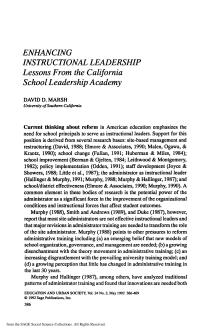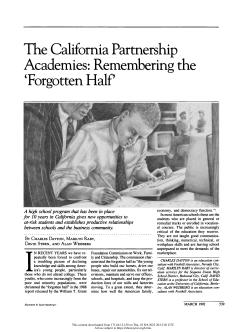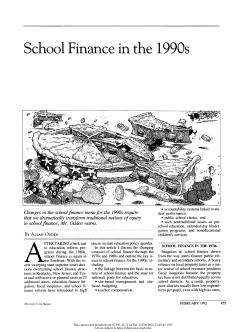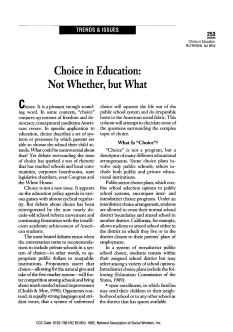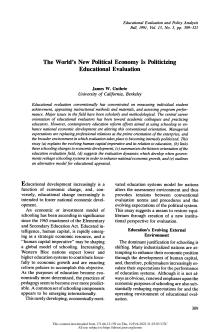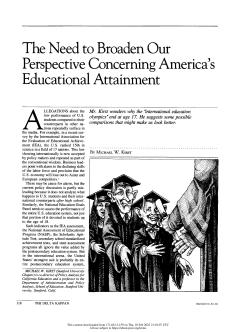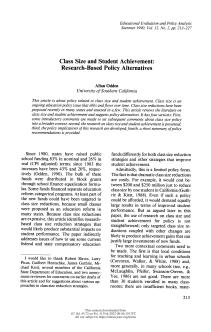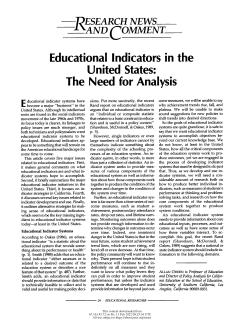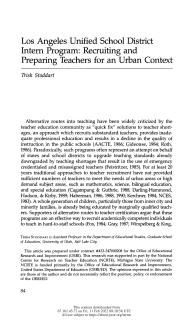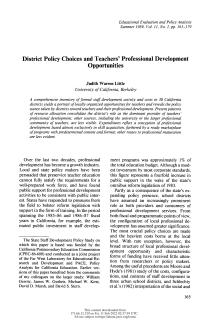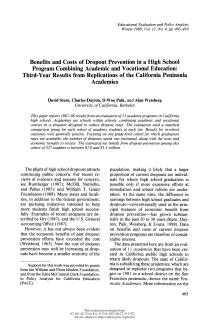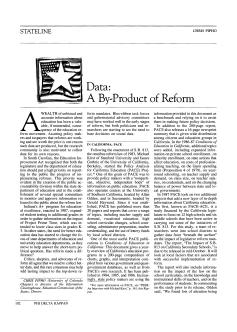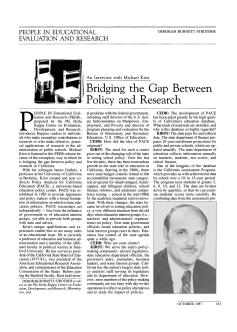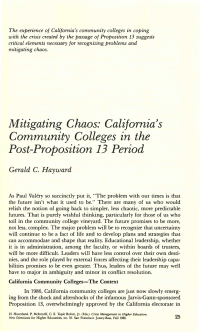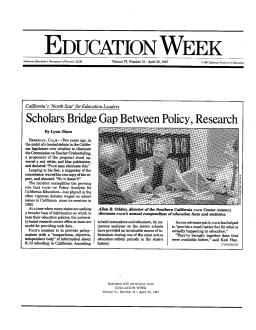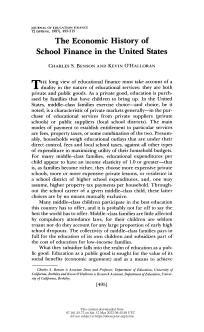Lessons from the California School Leadership Academy
Published
Summary
American education reform stresses the importance of principals as instructional leaders, but most are not effective in this role. Research suggests that innovative administrator training is needed to transform the role of site administrators. Content and process criteria have been identified, and several state-sponsored training programs have been established to meet them. One such program is the California School Leadership Academy, which provides a three-year program for aspiring and practicing site administrators with an emphasis on instructional leadership.
What Schools Must Do
Published
Summary
This article contends that school-linked services and education reform efforts are integrally related. Successful implementation of school-linked services requires new roles and responsibilities for all levels of school personnel. Drawing on general experience and citing specific examples from the New Beginnings experience in San Diego, the article outlines these new roles and responsibilities for school superintendents, board members, principals, and teachers. It describes the planning process involved, a process that includes an initial feasibility study and community needs assessment; a...
Remembering the "Forgotten Half"
Published
Summary
US high school students, especially those who do not attend college, have been found to lack skills and knowledge necessary for the job market. The California Partnership Academies program has been developed to address this issue and has been adopted by over 50 high schools. The program has received support and positive evaluations. Factors contributing to the issue include societal changes, the education system, and changes in the labor market. If these issues are not addressed, the US risks falling behind international competitors and a lower standard of living.
Published
Summary
School finance has become a prominent issue again due to court decisions and litigation in several states. This article explores school finance changes in the 70s and 80s and outlines key issues for the 90s, including the relationship between finance and education goals, site-based management, teacher pay, accountability, school choice, and nontraditional issues such as preschool and non-educational services for children.
Not Whether, But What
Published
Summary
Debate over school choice has been reignited due to the school reform movement and frustration with low academic achievement. The conversation becomes heated when private schools are included in the system of choice, as proponents believe it will foster competition and improve schools, while opponents argue it will harm public schools and society. This article aims to shed light on the complex issue of school choice.
Published
Summary
Traditionally, educational evaluation has focused on measuring student achievement and program performance. However, education reforms are now linking schooling to economic development, leading to a shift towards managerial expectations and politicization of the field. This article explains the human capital imperative and its relation to education, summarizes the history of educational evaluation, and outlines an alternative model for educational appraisal in the context of government-led education system reforms aimed at enhancing national economic growth.
Published
Summary
The U.S. ranks low in international education comparisons, but the discussion is misleading because it does not look at postsecondary education. The value added by the postsecondary education system, including community colleges, trade schools, and universities, is ignored. The U.S.'s strongest suit is probably its entire postsecondary education system in the international arena.
California and Senate Bill 813
Published
Summary
In 1983, the California legislature enacted a series of incentive programs intended, in part, to encourage local school districts to devote more resources toward instructional expenditures. Analysis of district response to those incentives shows they were more effective in directing spending toward direct instruction than were general or categorical grants. However, it appears that as the incentive funds were rolled into general aid revenues, district spending patterns began to revert to the same distribution of expenditures observed prior to enactment of the incentives.
Overcoming Barriers, Creating New Opportunities
Published
Summary
This article highlights the changing nature of childhood, with increasing physical and mental health problems, substance abuse, child abuse, inadequate child care, and family disorganization. Furthermore, schools struggle to meet the needs of non-middle-class, nonwhite, non-English-speaking children, as more students from these backgrounds enter public schools. To improve educational prospects, school leaders must recognize how children's daily lives affect their education and adapt to these changes.
Research-Based Policy Alternatives
Published
Summary
This article delves into the issue of class size in education, examining how it affects student achievement and suggesting policy alternatives. With some states proposing and implementing class size reductions, the analysis discusses the research on the subject and its policy implications. The piece is divided into four sections, starting with an introduction that provides context for the class size debate.
The Need for Analysis
Published
Summary
Educational indicator systems are in demand in the US due to their strong linkages to policy issues. This article covers five major issues related to educational indicators, including what they are, major initiatives in the US, and indicator strategies in California. It also discusses key issues related to indicator development and use and outlines alternative strategies for making sense of educational indicators, which are currently missing in the US.
Recruiting and Preparing Teachers for an Urban Context
Published
Summary
This article discusses the criticism of alternative routes to teaching, which are seen as inadequate and leading to declining instructional quality, but are attempting to address the shortage of qualified teachers in urban and high demand subject areas. Supporters argue that they are effective in recruiting competent teachers for hard-to-staff schools and replacing the emergency credential system with rigorous training. The article highlights the impact of teacher shortages on inner city and minority students who are currently being educated by marginally qualified teachers.
A Comparison of Education Reforms in the United States and Great Britain
Published
Summary
The new global economy is reshaping education worldwide, necessitating policies that expand access and enhance quality. Despite different educational systems, similar issues need to be addressed, resulting in an international convergence of education policies. The article discusses the emerging economy, educational challenges, policy alternatives, and compares recent reforms in the US and UK.
Issues and Options for Early Childhood Programs
Published
Summary
The growing demand for compensatory education and for child care has generated a rash of federal legislation; many states have enacted new early childhood programs, most of them located within schooling systems, and many others are considering their options. This article examines the basic policy issues governments confront in early childhood education, including the content of programs, their financing, and the inevitable trade-off between cost and quality. The final section of the article outlines the available policy options.
Published
Summary
An inventory of 30 California districts reveals their policy stance on teacher professional development, which primarily consists of skill acquisition through district-led programs. Other sources, such as universities or professional communities, are less visible. The districts are the dominant providers of development opportunities, with expenditures reflecting a ready marketplace of predetermined programs. Alternative routes to professional growth are less evident.
Third-Year Results from Replications of the California Peninsula Academies
Published
Summary
Evaluation of 11 California high school academies in 1987-88 found positive in-school outcomes. Academies combine academic and vocational courses to reduce dropout rates. Graduation rates available for one grade-level cohort, with an estimated net benefit of $1.0-1.3 million from dropout prevention.
An Exploration of the Debate on School District Size
Published
Summary
The notion that larger school districts are superior has changed, with some researchers advocating for smaller ones. Recent reform reports have focused on the school site as the decision-making seat. Three main issues guide district size research: fiscal efficiency, school effectiveness, and community identity. Although research has been conducted, there is still no definitive answer. This article explores the research and debate on the "right" size for school districts and identifies unanswered questions, hoping to kindle interest in further research.
Looking Backward and Forward
Published
Summary
1983 marked the beginning of state education reform with the release of the Nation at Risk report. Although many states had already passed education legislation, the last states joined in 1987. The reform's diffusion and breadth is impressive, and its consistency in concept makes it a hallmark in state policymaking. With initial statutes based on the 1983 concepts completed, the question remains whether a second wave will occur or if momentum has been spent.
Second-Year Results from Replications of the California Peninsula Academies
Published
Summary
This article discusses the results of replicating the California Peninsula Academies model in 10 high schools. The model provides technical instruction in an occupational field, alongside core academic curriculum, and is designed to prevent dropouts. Evidence suggests that Academy students performed better in terms of grades and course credits compared to students in comparison groups, particularly at three sites.
Published
Summary
This article examines whether state-level initiatives for school reform can improve local schools. California's comprehensive reform legislation, SB 813, aimed to alter curriculum and instruction in almost every school in the state. The effects of such a broad range of reforms on local districts and schools are not well understood. While earlier studies indicate that the reforms were being implemented, questions remain about how they operate in local schools and whether they result in substantive change. The answers to these questions are crucial for policymakers and practitioners alike.
A By-Product of Reform
Published
Summary
The Policy Analysis for California Education (PACE) Project provides nonpartisan information to policymakers about California's education system. Their "Conditions of Education in California" report is a yearly benchmark for policymakers. PACE also studies in-depth information on California's education system, including the impact of legislation on schools and the performance of students. Their research is widely distributed among education groups and citizens.
Bridging the Gap Between Policy and Research
Published
Summary
Michael Kirst, professor at Stanford University and former president of the California State Board of Education, is interviewed by People in Education Evaluation and Research (PEER). Kirst co-directs the Policy Analysis for California Education (PACE) project, an independent education policy center that provides unbiased research to legislators and policy makers. With Kirst's extensive experience in education and government, he is uniquely qualified to understand multiple sides of educational issues.
California's Community Colleges in the Post-Proposition 13 Period
Published
Summary
The passage of Proposition 13 in 1978 sent shockwaves through California's community colleges, affecting all aspects of their operations. The crisis exposed the colleges' lack of preparedness for such magnitude, leaving them grappling to cope with chaos. This article looks at California's experience and highlights critical elements necessary for recognizing problems and mitigating chaos. Educational leadership will need to be adept at ambiguity and conflict resolution as the future promises to be more complex and unpredictable. Finance, mission, and governance are the three key areas of focus.
Published
Summary
PACE, a university-based research center, provides "nonpartisan, objective, independent" information on K-12 schooling in CA. Its analyses have been invaluable to lawmakers and educators during the state's active education-reform period. PACE has played a growing role in debates on school issues, exemplified by a heated debate in the CA legislature over the Commission on Teacher Credentialing. PACE offers a model for providing data for education policies when many states are seeking broader information bases. It has helped provide a better understanding of what is happening in education.
Published
Summary
This paper argues that the components of educational provisions which satisfy private demands, mythology aside, almost invariably win out over the public goods components. If true, this leads, on the one hand, to a diminished supply of social benefits, and, on the other, to a stifling of social mobility. Insofar as these arguments are correct, they also may apply in most countries of the world, whether capitalist or socialist.
